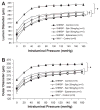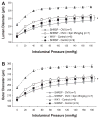Intact female stroke-prone hypertensive rats lack responsiveness to mineralocorticoid receptor antagonists
- PMID: 17670862
- PMCID: PMC2804103
- DOI: 10.1152/ajpregu.00145.2007
Intact female stroke-prone hypertensive rats lack responsiveness to mineralocorticoid receptor antagonists
Abstract
Data from the Framingham Heart Study suggest that women may be more sensitive to the deleterious cardiovascular remodeling effects of aldosterone. Previous studies from our laboratory have shown that chronic treatment with spironolactone, a mineralocorticoid receptor (MR) antagonist, decreases ischemic cerebral infarct size and prevents remodeling of the middle cerebral artery (MCA) in male spontaneously hypertensive stroke-prone rats (SHRSP). Therefore, we hypothesized that MR antagonism would reduce ischemic infarct size and prevent MCA remodeling in female SHRSP. Six-week-old female SHRSP were treated for 6 wk with spironolactone (25 or 50 mg.kg(-1).day(-1)) or eplerenone (100 mg.kg(-1).day(-1)) and compared with untreated controls. At 12 wk, cerebral ischemia was induced for 18 h using the intraluminal suture occlusion technique, or the MCA was isolated for analysis of passive structure using a pressurized arteriograph. MR antagonism had no effect on infarct size or passive MCA structure in female SHRSP. To study the potential effects of estrogen, the above experiments were repeated in bilaterally ovariectomized (OVX) female SHRSP treated with spironolactone (25 mg.kg(-1).day(-1)). Infarct size and vessel structure in OVX SHRSP were not different from control SHRSP. Spironolactone had no effect on infarct size in OVX SHRSP. However, MCA lumen and outer diameters were increased in spironolactone-treated OVX SHRSP, suggesting an effect of estrogen. Cerebral artery MR expression, assessed by Western blotting, was increased in female, compared with male, SHRSP. These studies highlight an apparent sexual dimorphism of MR expression and activity in the cerebral vasculature from hypertensive rats.
Figures







Similar articles
-
Spironolactone improves structure and increases tone in the cerebral vasculature of male spontaneously hypertensive stroke-prone rats.Microvasc Res. 2007 May;73(3):198-205. doi: 10.1016/j.mvr.2006.12.001. Epub 2007 Jan 23. Microvasc Res. 2007. PMID: 17250855 Free PMC article.
-
Spironolactone reduces cerebral infarct size and EGF-receptor mRNA in stroke-prone rats.Am J Physiol Regul Integr Comp Physiol. 2001 Sep;281(3):R944-50. doi: 10.1152/ajpregu.2001.281.3.R944. Am J Physiol Regul Integr Comp Physiol. 2001. PMID: 11507012
-
Regulation of myogenic tone and structure of parenchymal arterioles by hypertension and the mineralocorticoid receptor.Am J Physiol Heart Circ Physiol. 2015 Jul 1;309(1):H127-36. doi: 10.1152/ajpheart.00168.2015. Epub 2015 Apr 24. Am J Physiol Heart Circ Physiol. 2015. PMID: 25910805 Free PMC article.
-
Molecular mechanisms of mineralocorticoid receptor antagonism by eplerenone.Mini Rev Med Chem. 2005 Aug;5(8):709-18. doi: 10.2174/1389557054553811. Mini Rev Med Chem. 2005. PMID: 16101407 Review.
-
Pleiotropic actions of aldosterone and the effects of eplerenone, a selective mineralocorticoid receptor antagonist.Hypertens Res. 2004 Nov;27(11):781-9. doi: 10.1291/hypres.27.781. Hypertens Res. 2004. PMID: 15824460 Review.
Cited by
-
Contribution of Brain Processes to Tissue Loss After Spinal Cord Injury: Does a Pain-Induced Rise in Blood Pressure Fuel Hemorrhage?Front Syst Neurosci. 2021 Dec 15;15:733056. doi: 10.3389/fnsys.2021.733056. eCollection 2021. Front Syst Neurosci. 2021. PMID: 34975424 Free PMC article.
-
Mineralocorticoid receptor antagonism prevents obesity-induced cerebral artery remodeling and reduces white matter injury in rats.Microcirculation. 2018 Jul;25(5):e12460. doi: 10.1111/micc.12460. Epub 2018 Jun 7. Microcirculation. 2018. PMID: 29758591 Free PMC article.
-
Chronic aldosterone administration causes Nox2-mediated increases in reactive oxygen species production and endothelial dysfunction in the cerebral circulation.J Hypertens. 2014 Sep;32(9):1815-21. doi: 10.1097/HJH.0000000000000259. J Hypertens. 2014. PMID: 24991871 Free PMC article.
-
Endothelial cell Pannexin1 overexpression impairs ischemic stroke outcome in a sex-dependent manner.bioRxiv [Preprint]. 2025 Feb 8:2025.02.07.636909. doi: 10.1101/2025.02.07.636909. bioRxiv. 2025. PMID: 39975059 Free PMC article. Preprint.
-
30 YEARS OF THE MINERALOCORTICOID RECEPTOR: The role of the mineralocorticoid receptor in the vasculature.J Endocrinol. 2017 Jul;234(1):T67-T82. doi: 10.1530/JOE-17-0009. J Endocrinol. 2017. PMID: 28634267 Free PMC article. Review.
References
-
- Alkayed NJ, Harukuni I, Kimes AS, London ED, Traystman RJ, Hurn PD. Gender-linked brain injury in experimental stroke. Stroke. 1998;29:159–166. - PubMed
-
- Baumbach GL, Heistad DD. Remodeling of cerebral arterioles in chronic hypertension. Hypertension. 1989;13:968–972. - PubMed
-
- Brass LM. Hormone replacement therapy and stroke: clinical trials review. Stroke. 2004;35:2644–2647. - PubMed
-
- Carswell HV, Anderson NH, Clark JS, Graham D, Jeffs B, Dominiczak AF, Macrae IM. Genetic and gender influences on sensitivity to focal cerebral ischemia in the stroke-prone spontaneously hypertensive rat. Hypertension. 1999;33:681–685. - PubMed
-
- Carswell HV, Bingham D, Wallace K, Nilsen M, Graham DI, Dominiczak AF, Macrae IM. Differential effects of 17β-estradiol upon stroke damage in stroke prone and normotensive rats. J Cereb Blood Flow Metab. 2004;24:298–304. - PubMed
Publication types
MeSH terms
Substances
Grants and funding
LinkOut - more resources
Full Text Sources
Medical

